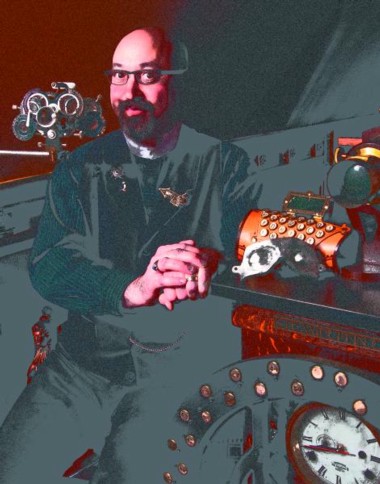Why do you think steampunk is popular?
There’s something called the IBM social sentiment index. It took them a few years, but they came up with an algorithm that takes hundreds of thousands of bits of info off the Internet to see what people are talking about—the volume, the categories. They compiled all this info and developed algorithms to determine what’s the next big design trend.
After all of this research, they announced early last year that for 2013 through at least 2015, the big design trend is steampunk. The experts in the field are saying—especially with the millennial generation—because of our economy and a reset of expectations in terms of their jobs and their lives, what they consider success might have to be different from what they thought. What’s important to them is meaning, being meaningful, authenticity. There’s a movement away from buying stuff at IKEA or Pottery Barn and you just throw it away. They’re tired of planned obsolescence and not having things be meaningful to them. Part of that is looking back at their own history and trying to make connections with—meaning with—the past, present and future. There’s where steampunk lies, in that world where you’re trying to have the best of all worlds. You’re looking back and matching up what was best then and matching it up with what’s best now and into the future.
A lot of the material you use is original to the Victorian era. What’s the appeal of those objects?
The artisans, craftspeople who made this stuff 100 years ago—it’s a lost art. People want to honor that, preserve that. We’re trying to bring a lot of that back. A lot of these objects are beautiful, but they’re obsolete. Technology has passed them by. We want to honor that by taking that object and giving it new life. I think people are looking back at the throw-away tech, and saying that was a time when people really took pride in their art. It wasn’t necessary to make an ornate boiler, but people didn’t have planned obsolescence—they intended it to last forever. People want this legacy; they don’t to just die and be forgotten.
When I’m giving seminars, that’s one area in which I really try to connect with people. The whole act of steampunking and repurposing helps you look at your own life—repurposing yourself. It’s really cathartic to be able to do this.
Working with metal, wood and old-fashioned technology doesn’t sound easy.
It’s very daunting. Tell you the truth, [as a designer] I don’t do this all myself. It’s usually a few people I work with. Like Sam [Ostroff], or someone who works with wood or electronics. It is collaborative—you’re learning, working with a team of people who are into the same kind of thing. I’ve become more of a project manager in bringing these artisans together. I come up with the vision, the idea, the concept and then I’ll figure out what we need, like someone who’s decorating a room will come up with an inspiration piece. …
I’m working on a very high level, but there are a lot of people who love doing this on their own. They love working on a lamp, for instance. It’s something that all of us can do; I’m just kind of taking it to a new level.
Do you think its popularity will continue?
People ask me if this is a fad. I don’t think so. The way I think of steampunk, I think of it as a creative problem-solving process. I’m trying to come up with ways to have the best of two worlds and create something new.
The idea is history plus art plus tech. I think that will morph and evolve and never get old. It might be a different era—it might be “decopunk.” I’m a steampunk artist and designer, but I’m looking at it in a broader way.•



